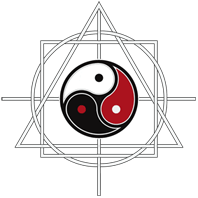
The First Personality Reading Based On
The Sacred Geometry Of Your Name Symbols.

Cartesian approach
The triple constitution of Human Being
Let's apply the analogical method to these three items :
| Mind | Soul | Body | |
|---|---|---|---|
| Mind | Mind in Mind | Soul in Mind | Body in Mind |
| Soul | Mind in Soul | Soul in Soul | Body in Soul |
| Body | Mind in Body | Soul in Body | Body in Bod |
Each world has its own characteristic element and a reflection in each of the other two.
| Mind | Soul | Body | |
|---|---|---|---|
| Mind | Reason | The Word | The Brain |
| Soul | Intuition | Feelings | The Heart |
| Body | Instinct | Will | The Physic |
You can see the meaning of each element in the grid below.
A ternary and fractal vision
This ternary approach was common in ancient Greece. Greek philosophers also applied it to man's central element, the psyche, which they divided into three distinct parts :
| Numbers | Bodies | Greece | Expression | Tools |
|---|---|---|---|---|
| Number 4 | Mind | Noos | Think | Eyes |
| Number 5 | Soul | Psyche | Feel | Word |
| Number 6 | Body | Soma | Do | Hands |
Worlds and reflections
This reading grid shows how the concepts of spiritus (mind), anima (soul) and corpus (body) are interconnected and mutually reinforcing. By using appropriate linking terms and adjusting explanations, we can better understand the vertical and horizontal relationships between these dimensions, enriching our understanding of ourselves and our place in the world.
How to express your will
If we start from the premise that we possess several bodies, and that what's below is like what's above, then if our physical body needs food to live, so do the other bodies, each of which has its own needs: mental, emotional and instinctive.
Likewise, if the physical body seeks an ideal of health, each of the different bodies has its own aspirations, its own ideals.
Each also has its own preferred organ of action: vision for the intellectual, speech for the emotional, and gesture for the instinctive.

| THE FIVE W's (*) | Principle | Spirit | Soul | Body |
|---|---|---|---|---|
| WHO acts? | Bodies | Mental Body | Emotional Body | Vital Body |
| WHAT: of what type is it? |
Type | Intellectual | Sentimental | Instinctive |
| WHERE: (part of the body) |
Organs | Brain | Heart | Belly |
| WHAT: what does it produce? |
Expressions | Thoughts | Feelings | Actions |
| WHAT: does it need? (Natural World) |
Needs | Light | Warmth | Power |
| HOW: priority mode of action? |
Tools | Eyes | Speech | Hands |
| WHY: in the service of what ideal? (Spiritual World) |
Ideals | Strength | Love | Wisdom |
| WHY: in the service of what Idea? (Spiritual World) |
Ideas | The True | The Good | The Beautiful |
From the Matrix to the Three
The human mind is divided into three main components: reason, thoughts, and the brain. Reason includes deductive, analogical, and inductive reasoning, each representing different methods of processing information. Thoughts encompass consciousness, beliefs, and common sense, reflecting internal mental processes. Consciousness is the awareness of oneself and the environment, beliefs form the core of an individual's values and understanding, and common sense is practical judgment derived from everyday experiences. The brain is divided into cognitive, limbic, and reptilian parts, each with distinct functions: intellectual, emotional, and instinctive, respectively.
The soul comprises intuition, feelings, and the heart. Intuition includes illumination, telepathy, and precognition, often subconscious perceptions. Illumination is intuitive clarity, telepathy is the transfer of thoughts without conventional senses, and precognition is the perception of future events. Feelings include virtues, emotions, and willpower. Virtues are moral qualities, emotions are complex reactions, and willpower is the control to overcome obstacles. The heart is associated with nutrition, breathing, and circulation, essential to physical and emotional health.
The body is divided into instinct, actions, and the belly. Instinct involves reproduction, relationships, and survival, innate behaviours essential for life. Actions involve the eyes, speech, and hands, representing physical activities and expressions. The eyes are organs of vision, speech is verbal expression, and hands are used for various tasks. The belly focuses on alimentation, sexuality, and digestion, processes that nourish and sustain the body.
